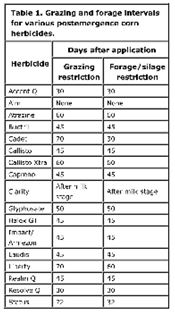Be Aware Of The Potential For Herbicide Carryover
URBANA, ILL.
Dry soil conditions like those experienced in most of Illinois this growing season are not always conducive for achieving good weed control with soilresidual herbicides. Dry soil also slows the rate of herbicide degradation, which can increase the potential for damage to subsequent crops from herbicide carryover. Many factors interact to determine how long a herbicide remains active in the soil environment, including factors related to the herbicide, the soil, and climactic conditions.
Herbicides vary in their persistence in the soil; some, such as thifensulfuron, have very little soil activity, while others, such as picloram, can persist for several months. Variation can even exist among herbicides in the same chemical family. For example, within the imidazolinone herbicide family, soil persistence of imazamox is much shorter than that of imazethapyr. The characteristics of the herbicide molecule that contribute to long soil persistence are inherent properties, and little can be done to shorten their persistence once they have been applied.

Soil properties that influence herbicide persistence can be broadly categorized into chemical, physical, and microbial. One of the more important chemical factors that influences persistence of some herbicides is pH. Soil pH impacts how much herbicide is available for plant uptake and how quickly the herbicide is degraded by the chemical process known as hydrolysis. For example, atrazine is more available for plant uptake when soil pH is high (say, 7.0 or higher), but atrazine also persists longer because the rate of hydrolysis slows at higher soil pH values. The degradation rate of many sulfonylurea herbicides also slows with high soil pH values, whereas imidazolinone herbicides persist longer in soils with low pH values.
Physical properties of soil relate to the relative amounts of sand, silt, clay, and organic matter a soil contains. Soils with higher amounts of clay and organic matter have more potential for herbicide carryover than coarse-textured soils or those with less organic matter. Higher amounts of soil organic matter and certain types of clay particles increase the potential for herbicide carryover by adsorbing more herbicide onto these soil colloids. Herbicide bound to soil colloids is not available for plant uptake, movement downward through the soil profile, or microbial degradation. Injury to rotational crops is possible if these bound residues are displaced by water molecules either late in the season they were applied or the following spring.
Soil microorganisms are responsible for the degradation of many herbicides. The composition of microorganisms (species and abundance) in a particular soil influences how quickly herbicide degradation occurs. The activity of soil microorganisms is influenced by several factors, including soil moisture. Herbicide degradation by soil microorganisms usually occurs most rapidly when adequate soil moisture is present; under extremely dry conditions the rate can slow enough to allow the herbicide to persist into the next growing season.
How can producers minimize the risk of injury to rotational crops from herbicides applied this season? Apart from a return to normal or abovenormal precipitation, little can be done to accelerate herbicide degradation at this point in the season; the process simply takes time (and moisture). Shallow tillage can help distribute herbicide more evenly across a field, but it will do little itself to accelerate herbicide degradation when soils are excessively moisture-deficient. Early planting next season (assuming field conditions are conducive) might further increase the likelihood of crop injury from herbicide carryover.
Planting the same crop next season as in 2012 would effectively eliminate the potential for crop injury from herbicide residues. This solution may not be feasible for every situation where herbicide carryover is possible, but it is an option that warrants some consideration. If crop rotation must occur where there is concern for herbicide carryover, delaying planting as long as possible could allow additional herbicide degradation to occur.
Is it feasible to plant a cover crop, fall forage crop, or small-grain crop after the 2012 corn crop is harvested or destroyed? Keep in mind that the labels of almost all corn herbicides include crop rotation intervals specifying the time that must elapse between application and planting the rotational crop. In many instances, the interval between application and planting winter wheat will not be satisfied this calendar year. Small-grain crops can be sensitive to even small amounts of herbicide residue (such as atrazine) that remain in the soil. Herbicide labels might not list every possible rotational crop; rather, they often fall into the most restrictive interval on the label.
Finally, labels of most corn herbicides also indicate an interval that must elapse between application and harvest for grain, silage, or grazing. Intervals for a number of herbicides are listed in Table 1. Δ
DR. AARON HAGER: Extension Specialist, Weed Science/IPM, University of Illinois